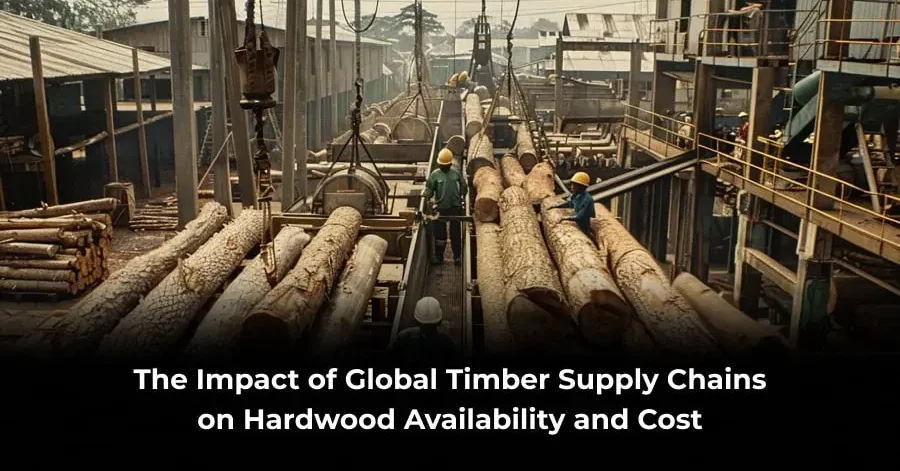There’s a moment of pure connection when a woodworker runs a hand over a freshly sanded board. The grain reveals itself, a unique story of rainfall, soil, and sunshine etched in time. For a builder, it’s the satisfaction of selecting the perfect decking or flooring, knowing its strength and beauty will last for generations. But have you ever stopped to wonder about the incredible, often tumultuous, journey that piece of wood took to reach your workshop or local lumberyard? The story of hardwood is no longer just a local tale; it’s a complex global narrative of supply chains, international demand, and ecological balance that directly impacts what’s on the shelf, the choices you have, and what you pay for it.
This intricate dance between global forces and local availability is more relevant than ever. Whether you’re a seasoned professional searching for specific hardwood timber for sale or a hobbyist browsing the aisles of a woodworking supplies store, understanding these connections empowers you to make smarter, more sustainable choices. It transforms the act of buying wood from a simple transaction into a conscious decision with global ramifications.
The Modern Timber Supply Chain: A Delicate Web of Interdependence
Gone are the days when the wood for your furniture came from the forest a few towns over. Today’s timber supply chain is a sprawling, interconnected, and often delicate web spanning continents. It begins with sustainable forestry practices or, in less regulated regions, concerning logging operations. From there, the raw logs embark on an international voyage that would rival any great adventure.
- Harvesting & Regulations: The Critical First Step: The journey starts at the source, deep within forests managed under vastly different philosophies. Countries like the United States and Canada have robust, though not perfect, forestry management systems. In contrast, operations in parts of the Amazon Basin or West Africa can be a patchwork of strict sustainability and illegal clear-cutting. This initial step is crucial, as it sets the tone for the entire chain. Reputable hardwood timber suppliers are increasingly vigilant about sourcing only from verifiably legal and sustainable operations, often requiring documentation like FSC (Forest Stewardship Council) certification. This isn’t just about ethics; it’s about ensuring the long-term viability of their own business. The harvest of a specific species, such as the versatile okoume wood, is often governed by strict quotas in countries like Gabon to prevent over-exploitation, immediately influencing global availability from the very outset.
- Processing & Milling: Adding Value and Stability: Once harvested, logs are rarely shipped in their raw, round form. They are often rough-milled in their country of origin to reduce shipping weight and cost—a practical step that also supports local economies. This is a specialized skill, requiring an understanding of how different species behave. For instance, milling okoume wood requires techniques that minimize waste of its valuable, wide boards, which are often sliced into veneers for plywood. The lumber is then dried, either slowly through air-drying or more rapidly in kilns, to stabilize it and prevent warping. This processing stage adds significant value and is a point where quality can be either assured or compromised. Inconsistent drying can lead to wood that is unstable once it reaches a different continent’s climate, a hidden cost that may not be apparent until long after purchase.
- The International Marketplace: The Arena of Fluctuation: This is where the global market truly flexes its muscles. Processed timber is sold to international brokers and importers, and it’s here that prices are truly set. Fluctuations in global demand, particularly from massive infrastructure projects in Asia or the manufacturing sector in Europe, can create bidding wars, driving up prices worldwide. If a major consumer suddenly needs a large quantity of a specific species for a new line of furniture or flooring, the entire supply chain feels the ripple effect. This marketplace is also sensitive to currency exchange rates; a strong US dollar makes American imports cheaper for European hardwood timber suppliers, while a weak dollar has the opposite effect, tightening supply domestically.
- Distribution & The Local Store: The Final Link: After clearing customs and undergoing rigorous inspections (especially for CITES-listed protected species), the wood finally reaches domestic distributors. These distributors are the critical, and often underappreciated, link between the global market and your local woodworking supplies store. They act as strategic reservoirs, holding vast inventories to smooth out the bumps in supply. They absorb some of the price volatility, though not all, to provide their customers with a degree of consistency. A reliable distributor’s ability to forecast demand and stockpile accordingly is what prevents a project from grinding to a halt when a shipment is delayed halfway across the world.
This complex system, while efficient in scaling to meet global needs, is inherently fragile. A storm disrupting shipping lanes in the Panama Canal, a new political tariff on imported wood, or a pandemic halting production can snarl the entire chain, leading to shortages and price spikes that you’ll inevitably see the next time you look for hardwood timber for sale.
The Direct Impact on Hardwood Availability and Cost: From Forest to Finance
So, how does this convoluted global web translate to the tangible reality for you, the craftsman, builder, or DIY enthusiast? The impact is profound and twofold: it dictates what you can buy and how much you will pay for it.
1. The Shifting Sands of Availability
The incredible diversity of species available at your local yard is a direct reflection of globalized supply chains. Decades ago, you might have had a choice of a few local staples like oak, maple, and pine. Today, you can find exotic species from every continent—African Mahogany, Brazilian Cherry, European Beech. This is a boon for creativity but a significant challenge for consistency and planning.
Take okoume wood, for instance. Prized for its light weight, stability, and excellent performance as a plywood core, it is sourced almost exclusively from the equatorial forests of West Africa. Its availability in North America or Europe is entirely dependent on a precarious balance: stable political conditions in Gabon or Congo, scientifically-set sustainable harvesting quotas, and clear shipping lanes from the port of Libreville. If a new international regulation like the Lacey Act restricts its harvest or import to protect the species, it can vanish from the market almost overnight, forcing boat builders, cabinet makers, and veneer manufacturers to scramble for alternatives. This constant juggling act is the daily reality for hardwood timber suppliers who must balance customer demand with ethical and available supply, often having to gently guide clients toward a suitable substitute when their first choice is trapped in a logistical or regulatory bottleneck.
2. The Complex Calculus of Cost
The price tag on that beautiful slab of walnut or stack of maple isn’t arbitrary. It’s the sum total of its global journey, a cumulative receipt of every hand it passed through and every mile it traveled. Let’s break down the cost drivers that pile onto that final number:
- Fuel and Freight Costs: The Transportation Multiplier: This is one of the most significant and volatile variables. The cost to ship a 40-foot container from Southeast Asia to the United States can triple during times of global economic strain, geopolitical conflict, or fuel price hikes. This isn’t a minor expense; it’s a multiplier that affects every piece of wood in that container. This added cost is inevitably passed down the chain, from the importer to the distributor, to the woodworking supplies store, and finally, to you. When you see prices climbing, often the first place to look is the global shipping index.
- International Tariffs and Trade Policies: The Political Wild Card: Trade wars and tariffs can instantly make certain imported woods prohibitively expensive. A tariff on a species like beech or oak from Europe doesn’t just affect those specific boards; it forces suppliers to seek new sources, often at a higher cost, or compels consumers to pay a premium. This political wild card adds a layer of uncertainty that makes long-term pricing and project budgeting a challenge for everyone, from large-scale hardwood timber suppliers to the individual customer.
- Global Demand: The Invisible Hand Squeezing Supply: The fundamental law of supply and demand is unforgiving in a globalized market. As emerging economies build and manufacture more, their consumption of raw materials, including hardwood, increases exponentially. This global competition for a finite resource naturally drives prices upward for everyone. A construction boom in Vietnam can increase the demand for okoume wood for concrete formwork, making it more expensive and harder to find for a luthier in Tennessee who uses it for guitar bodies.
- Currency Exchange Rates: The Silent Influencer: The value of your currency on the world stage directly impacts the cost of imported goods. When the U.S. dollar is strong, imported wood becomes cheaper for American buyers. When it weakens, the cost of that same okoume wood or teak from overseas increases. Your local supplier’s pricing is subtly tied to the daily fluctuations of the global currency market, a factor entirely outside their control.
This is why building a relationship with knowledgeable hardwood timber suppliers is so valuable. They can provide context for price changes, explain why a certain species has become scarce, and advise on more stable, cost-effective alternatives that possess similar working properties and beauty.
Navigating the New Normal: Practical Tips for Woodworkers and Builders
In this volatile and interconnected environment, what can you, the end-user, do to mitigate disruption and manage costs?
- Embrace Flexibility and Discovery: Be open to alternative species. If your traditional choice is too expensive or unavailable, ask the experts at your woodworking supplies store for a recommendation. You might discover a domestic species like Sycamore or Pecan that offers a stunning aesthetic you hadn’t considered, often at a better price point and with a smaller carbon footprint.
- Plan and Purchase Ahead with a Strategic Mindset: The era of last-minute lumber runs for large projects may be fading. Forward-planning allows you to buy what you need when you see it available, avoiding project delays. If you have storage space, consider buying a small stockpile of your most-used woods when you find a good price, effectively creating your own buffer against market spikes.
- Build Relationships, Not Just Transactions: Don’t just see your supplier as a store. See them as a partner in your craft. Local hardwood timber suppliers and the managers at a well-stocked woodworking supplies store have their finger on the pulse of the market. They can offer invaluable advice on market trends, hold wood for you if they know your needs, and give you a heads-up when a rare shipment is coming in.
- Value Quality and Sustainability over Mere Price: In a high-cost environment, it makes more sense than ever to invest in quality wood for a project that will last. Choosing sustainably sourced lumber from responsible hardwood timber suppliers isn’t just an ethical choice; it’s an investment in the future of the craft and the material itself. Cheap, inferior material that may warp, crack, or come from questionable sources is a far greater financial and environmental cost in the long run.
Spotlight on AEW Woods: A Supplier Navigating a Globalized World
In the midst of this complex and often unpredictable global market, the role of dedicated, reliable, and strategically minded hardwood timber suppliers becomes paramount. This is where companies like AEW Woods carve out their essential space. Understanding the pressures that designers, architects, specifiers, and woodworkers face, AEW Woods has built a formidable reputation on navigating the intricacies of the global supply chain so their customers don’t have to.
AEW Woods focuses on providing consistent, reliable access to high-quality, often specialty, hardwoods. They act as a crucial buffer against market volatility, holding extensive and diverse inventory to ensure that when a customer is looking for a specific hardwood timber for sale, whether it’s a common domestic species or a more exotic one like okoume wood, they have it in stock and ready to go. Their expertise allows them to source responsibly and intelligently, offering options like okoume wood and other exotics with the paperwork to prove their legality and sustainability. For anyone from a large commercial contractor to a passionate amateur stocking up at a woodworking supplies store, having a supplier like AEW Woods that prioritizes a steady, reliable supply and deep industry knowledge is an invaluable asset in an unpredictable world. They transform the complexity of global logistics into the simple certainty of having the right board on the bench when you need it.
Also Read – How to Repair and Restore Damaged Okoume Marine Plywood
Conclusion
The piece of hardwood in your hands is more than just a material; it’s a global citizen. Its journey from a forest on another continent to your local woodworking supplies store is a testament to our interconnected world. This global timber supply chain, while offering an incredible diversity of choice, also introduces fragility and cost volatility that affects us all.
By understanding these forces—the shipping costs, the international demand, the regulatory hurdles—we become more informed consumers. We can better appreciate the value offered by dedicated hardwood timber suppliers who work to stabilize supply. We can learn to be flexible in our material choices, perhaps discovering a beautiful domestic alternative or learning to work with a stable plywood made from okoume wood. In the end, this knowledge doesn’t just save us money and frustration; it deepens our connection to the craft, transforming us from mere buyers into conscious participants in the timeless, yet ever-evolving, story of wood.
Frequently Asked Questions (FAQs)
- Why has the price of hardwood lumber increased so much recently?
Prices are influenced by a combination of factors including increased global demand, high international shipping and freight costs, tariffs on imported wood, and supply chain disruptions from geopolitical events or weather. It’s rarely one single cause but a confluence of global pressures. - I’m looking for a specific type of hardwood timber for sale, but my local store is always out. What’s going on?
Global shortages of specific species occur due to high international demand, logging quotas set by producing countries to protect forests, or logistical snarls in the supply chain. A species like okoume wood, for example, can become scarce if export permits are delayed or harvesting is limited for sustainability. - How can I ensure the wood I buy is sustainably sourced?
Always purchase from reputable hardwood timber suppliers who are transparent about their sourcing. Look for certifications like the Forest Stewardship Council (FSC) or the Programme for the Endorsement of Forest Certification (PEFC) on the wood or their documentation. - Are domestic hardwoods a more reliable and cheaper option than imported ones?
Often, yes. Domestic species like oak, maple, and cherry have shorter, less volatile supply chains, making them less susceptible to international freight costs and tariffs. They are often more consistently available and can be more cost-effective, though this depends on the specific species and current demand. - My local woodworking supplies store has limited selection. Where else can I look?
Beyond big-box stores, seek out specialized lumberyards and hardwood timber suppliers who cater to professionals. These businesses, like AEW Woods, typically carry a much wider and higher-quality selection of domestic and exotic hardwoods and can often order specific items for you.






